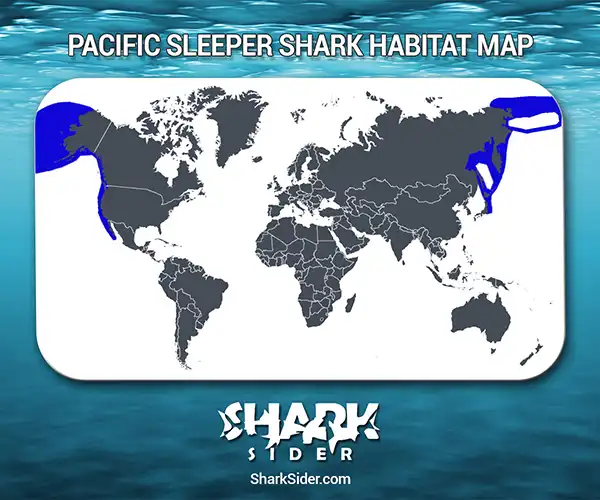The Pacific Sleeper Shark, also called the Somniosus pacificus in the scientific community, belongs to the belongs to the Somniosidae shark family. However, unlike its close cousins, it does not grow over 23 feet (7 meters). One of these sharks was recently filmed using bait in the Tokyo Bay (Japan) which measured at 7 meters or 23 feet. At maturity, they typically weigh around 340 kilograms or 750 pounds and are normally around 12 feet in length, or about 3.6 meters.
The Pacific Sleeper Shark has a rounded and a short snout. It is grey or grayish-black in color and has a bristly and rough skin. They have a cylindrical body and the dorsal fins are low.
Studying the Pacific Sleeper Shark’s feeding habits and diet in Alaska has revealed that they feed mostly on giant Pacific Octopus, soles, pollocks, flounders and teleost fish. When available to them, they will also eat hermit crabs, rockfishes, marine snails, pacific salmon, squids and shrimps. Their feeding habits generally depend on the geographical area they live in and on the availability of prey.
Habitat
Map Of The Pacific Sleeper Shark’s Habitat

The Pacific Sleeper Shark is found almost all around the planet, although they prefer to swim in deeper or colder waters. Depths from the surface to more than 2000 meters or 6,500 feet deep are common (that’s more than a full mile under water!). They are known to avoid light and swim at depths under the photic surface during the day and come up to surface at night. That makes them a rare sighting by humans. This shark can be found in abundance in Japan’s north Pacific and occurs right along the Siberian coast into the Bering Sea. It is also found further south across the Califronian and Mexican coasts. Another favorite habitat of Pacific Sleeper Sharks is the seamounts to the south of Tasmania, the Macquarie Island, and the Challenger Plateau off New Zealand. They have also been found in good numbers off Uruguay.
One of the most interesting features of the Pacific Sleeper Shark is that they are predominantly scavengers and rarely hunt. They are very slow but can move in the water elegantly and without much effort of body movement. The lack of movement allows them to catch prey easier because they don’t make much noise. Their feeding habit is also a little different and they feed using cutting and suction. Because of their large mouths, they can use suction to suck the prey in and the teeth help in cutting down pieces that cannot be swallowed (they swallow by rolling their heads).
They have the right kind of teeth for feeding. The upper teeth are spear-like and strong while the lower ones are built for slicing. They are known to have one of the most powerful bites of all sharks studied, so don’t go sticking your hand in their mouths if you see one!
Another great feature is that they can change depths at the rate of about 200 meters or 650 feet per hour.
Social Behavior
Since the Pacific Sleeper Shark is not a predominant hunter, they are found mostly in smaller groups. Since scavenging is their main way of feeding, being in smaller groups is more beneficial for them.
While they are considered a threat to humans, it’s mostly only due to their enormous their size. There has also been very little human interaction with this shark, so it’s not exactly known how this shark would react to a human in its environment. Moreover, the Pacific Sleeper Shark swims at unfishable depths. To date, most of them which have been caught have been placed back into the sea. Most of them are juveniles that grow in shallow waters before adapting to deeper seas. No known conservation steps have been taken since the species is not considered threatened (let’s keep it that way!).
Due to the lack of food sources at the depths they prefer, they tend to store food for long periods. The stomach of this shark has enough space to do so. The shark also has the right chemicals on the skin to render its proteins stable at great depths. This is very essential to enable the shark to swim comfortably and efficiently. And finally, it ensures that the reproductive and digestive hormones stay stable at such depths and high pressure.
Offspring
There is not much known about adolescent Pacific Sleeper Sharks. The reproductive cycle and the other details are not readily available. However, it is quite well known that these sharks follow the Ovoviviparous reproductive cycle which means the hatching of egg capsules occurs inside the mother’s uterus. The female usually has about 300 eggs ready to fertilize once she comes of age. The gestation (pregnancy) period has not been accurately measured and the litter size is known to be around 10 pups. The newborn pups are known to measure about 1.38 feet (or 42 centimeters).
